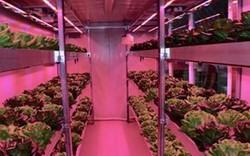 ENEA set up the Ri-Genera project to turn abandoned buildings into vertical hydroponic greenhouses that guarantee a larger production of vegetables while using little water and without using pesticides.
ENEA set up the Ri-Genera project to turn abandoned buildings into vertical hydroponic greenhouses that guarantee a larger production of vegetables while using little water and without using pesticides.
The project was initiated in the Veneto region by Coldiretti Padova, Parco Scientifico e Tecnologico Galileo, Advance Srl, Idromeccanica Lucchini Spa and Gentilinidue.
It is based on the "Arkeofarm" system, created by ENEA in collaboration with Idromeccanica Lucchini and consisting in a solution for intensive vegetable cultivation on multiple vertical levels. "Advanced hydroponic techniques are used in a closed conditioned environment with LED artificial lighting. The solution can be highly automated thanks to robotized systems for sowing, harvesting and even packaging," explains ENEA researcher Gabriella Funaro.
The vertical greenhouse becomes a new urban "element" that is easily adaptable thanks to the possibility of being located both in buildings with no particular qualities, even without windows, and in historic buildings or with specific architectural constraints, as it makes it possible to keep them unaltered.
ENEA and Idromeccanica Lucchini also created a vertical farm mobile model called "BoxXLand" for the closed-cycle vertical cultivation of vegetables in containers. "In this case too, no pesticides are used and LED lights are employed, while irrigation and air conditioning are managed by a software."
Both models can be used to redevelop entire degraded areas thus stimulating the growth of advanced agricultural and food districts.
"The fact many private companies and institutions in northern Italy were interested in this solution hopefully means we will be able to export it all over Italy and abroad. This is why we have come up with activities to raise the awareness of producers, consumers and institutions on the benefits of hydroponic cultivation techniques and vertical farming when it comes to environmental, economic and social sustainability."
The first prototype of vertical farm was set up by ENEA during the 2015 Expo in Milan and obtained the "Seal of Excellence" by the European Commission. It was also displayed in many national and international fairs.
Source: TeleBorsa
